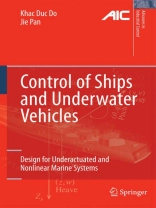Most ocean vessels are underactuated but control of their motion in the real ocean environment is essential. Starting with a review of the background on ocean-vessel dynamics and nonlinear control theory, the authors’ systematic approach is based on various nontrivial coordinate transformations coupled with advanced nonlinear control design methods. This strategy is then used for the development and analysis of a number of ocean-vessel control systems with the aim of achieving advanced motion control tasks including stabilization, trajectory-tracking, path-tracking and path-following.
Control of Ships and Underwater Vehicles offers the reader: – new results in the nonlinear control of underactuated ocean vessels; – efficient designs for the implementation of controllers on underactuated ocean vessels; – numerical simulations and real-time implementations of the control systems designed on a scale-model ship for each controller developed to illustrate their effectiveness and afford practical guidance.
Зміст
Mathematical Tools.- Mathematical Preliminaries.- Modeling and Control Properties of Ocean Vessels.- Modeling of Ocean Vessels.- Control Properties and Previous Work on Control of Ocean Vessels.- Control of Underactuated Ships.- Trajectory-tracking Control of Underactuated Ships.- Simultaneous Stabilization and Trajectory-tracking Control of Underactuated Ships.- Partial-state and Output Feedback Trajectory-tracking Control of Underactuated Ships.- Path-tracking Control of Underactuated Ships.- Way-point Tracking Control of Underactuated Ships.- Path-following of Underactuated Ships Using Serret–Frenet Coordinates.- Path-following of Underactuated Ships Using Polar Coordinates.- Control of Underactuated Underwater Vehicles.- Trajectory-tracking Control of Underactuated Underwater Vehicles.- Path-following of Underactuated Underwater Vehicles.- Control of Other Underactuated Mechanical Systems.- Control of Other Underactuated Mechanical Systems.- Conclusions and Perspectives.
Про автора
Doctor Do’s major contribution to systems and control is his research on control of systems subject to nonholonomic constraints such as underactuated mechanical systems including surface ships, underwater vehicles, mobile robots and aircraft, and control of networks of multiple vehicles. He has made significant contribution to the understanding dynamics and developing novel methods to design controllers for these systems. For nonholonomic systems with strong nonlinear drifts and unknown parameters, he developed a method called ‘input-to-state scaling’ to design a global asymptotic stabilizer. For land, air and ocean vehicles, he proposed various solutions to the problems of stabilization, trajectory-tracking and path-following. He introduced a methodology called ‘dynamics from a different view’, which results in several ways to derive coordinate transformations to overcome difficulties in controlling these vehicles. His involvement with Western Australia ship- and air-vehicle-building industries (Austal, Shipdynamics, Entecho) has enriched his industrial activities and practical experience. Currently, he is a senior lecturer in the School of Mechanical Engineering at the University of Western Australia. He teaches ‘Advanced Control Engineering’ and ‘Navigation and Marine Control Systems’ units.
Professor Jie Pan is the Director of the Centre for Acoustics, Dynamics and Vibration at the School of Mechanical Engineering, University of Western Australia. His contribution to the field of applied control was initially in active control of noise and structural vibration. Since 1999, he and his research team have worked on the control of ocean vessel vibration and motion, where he played a role not just as a team leader and project organiser, but also provided physical insight into the understanding of system dynamics and their role in controller design. He also established several fundamental and industrial research projects on active control of marinevessels’ vibration, and active vibration control of marine risers, from which several outstanding Ph D, Masters and final-year theses were generated and some problems of ride control systems in the Western Australian ship-building industry were solved. Many results described in this monograph are the products or by-products of those projects and thesis work. Professor Pan’s teaching covers classical control, advanced control and mechatronics, vibration and signal processing, and acoustical engineering.












